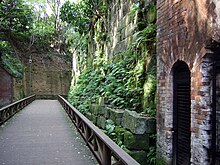Sarushima
| Sarushima | ||
|---|---|---|
| Aerial view of Sarushima | ||
| Waters | Tokyo Bay | |
| Geographical location | 35 ° 17 '10 " N , 139 ° 41' 39" E | |
|
|
||
| length | 500 m | |
| width | 200 m | |
| surface | 5.5 ha | |
| Highest elevation | 40 m | |
| Residents | uninhabited | |
| Sarushima | ||
Sarushima ( Japanese 猿 島 , dt. "Monkey Island") is a Japanese island in the Bay of Tokyo .
The island is uninhabited, but because of a cave in which the Buddhist reformer Nichiren stayed, its bathing beach, the fortifications and its popular culture mentions, it is important for tourists.
geography
The 0.055 km² island is located in Tokyo Bay about one kilometer from Yokosuka , to which it also belongs administratively. Sarushima is described as the largest natural island in the bay, as there are a large number of larger land masses, but they are completely artificial or have been significantly reshaped by landfills. The highest point on the island is 40 m.
history
Ceramic shards from the Jōmon period (10,000 to 300 BC) as well as human bones and pots from the Yayoi period (5th century BC to 3rd century AD) were found on the island let an early settlement close. Sarushima was originally called Toyoshima ( 豊 島 ) until the Buddhist reformer Nichiren was shipwrecked in a storm in front of the island in 1253 while crossing from his home Awa to Kamakura . While looking for accommodation, a white monkey is said to have shown him the way to the cave in the north. Because of this episode, the island got its name.
Because of its strategically important location as the only island between the Pacific Ocean and the seat of government Edo (today: Tokyo ), the Tokugawa shogunate had three gun batteries with 15 cannons built on Sarushima in 1847 in view of the threat from western ships. When in 1853 Matthew Calbraith Perry forced the opening of Japan with his Black Ships in the port of Uraga , he noted the nearby Sarushima as Perry Island on his maps. After the Meiji Restoration , the island was expanded into a western-style fortress, which was completed in 1884. It then formed with the sea fortresses 1–3 ( 第一 ・ 第二 ・ 第三 海 堡 ) - islands that were artificially created between Sarushima and Cape Futtsu, 8.5 km to the east, - the defense ring of Tokyo Bay. After the systems were modernized with anti-aircraft guns in 1941 , the island was given the nickname Gunkanjima ( 軍艦 島 , "Warship Island ").
After World War II , the island came under the control of the US military, which removed the guns; but it was held in trust by the Japanese Ministry of Finance . In 1961 the island was finally returned to Japan. In 1957 the beach was opened to bathers, but in 1993 access to the island was initially banned due to disputed responsibilities. This was reversed in 1995/6 after the state first handed over the island to the city of Yokosuka in trust and finally handed it over completely in 2003. From the handover to 2013, the number of visitors increased 1.7 times to 110,000 annually, which is mainly due to the fact that Sarushima is supposed to resemble the flying island from Hayao Miyazaki's anime film The Castle in the Sky . It also serves as a secret hideout for the antagonists in the Tokusatsu television series Kamen Rider , which has been running since the 1970s .
Web links
Individual evidence
- ↑ a b c 猿 島 . In: 知 恵 蔵 mini at kotobank.jp. Retrieved August 12, 2015 (Japanese).
- ↑ a b c d 猿 島 (さ る し ま) . In: 日本 の 島 へ 行 こ う . Retrieved August 12, 2015 (Japanese).
- ↑ 【横須賀 市 猿 島 1 番地】 日 蓮 伝 説 の 宝庫 ☆ 猿 島 (さ る し ま) | 廣 榮 山 蓮華 寺 . Nichiren-shu , February 5, 2013, accessed August 12, 2015 (Japanese).
- ↑ a b 猿 島 大 冒 険! . (No longer available online.) In: 三浦 半島 へ 行 こ う! . November 5, 2001, archived from the original on August 22, 2015 ; Retrieved August 12, 2015 (Japanese). Info: The archive link was inserted automatically and has not yet been checked. Please check the original and archive link according to the instructions and then remove this notice.
- ↑ Yukiko Oga: Fame for a tiny island that evokes images of Hayao Miyazaki's masterpiece. In: The Asahi Shimbun. May 4, 2015, archived from the original on March 4, 2016 ; accessed on August 2, 2016 .
- ↑ Lone Rehnström: Yokosuka. In: Metropolis. April 29, 2010, accessed August 12, 2015 .



